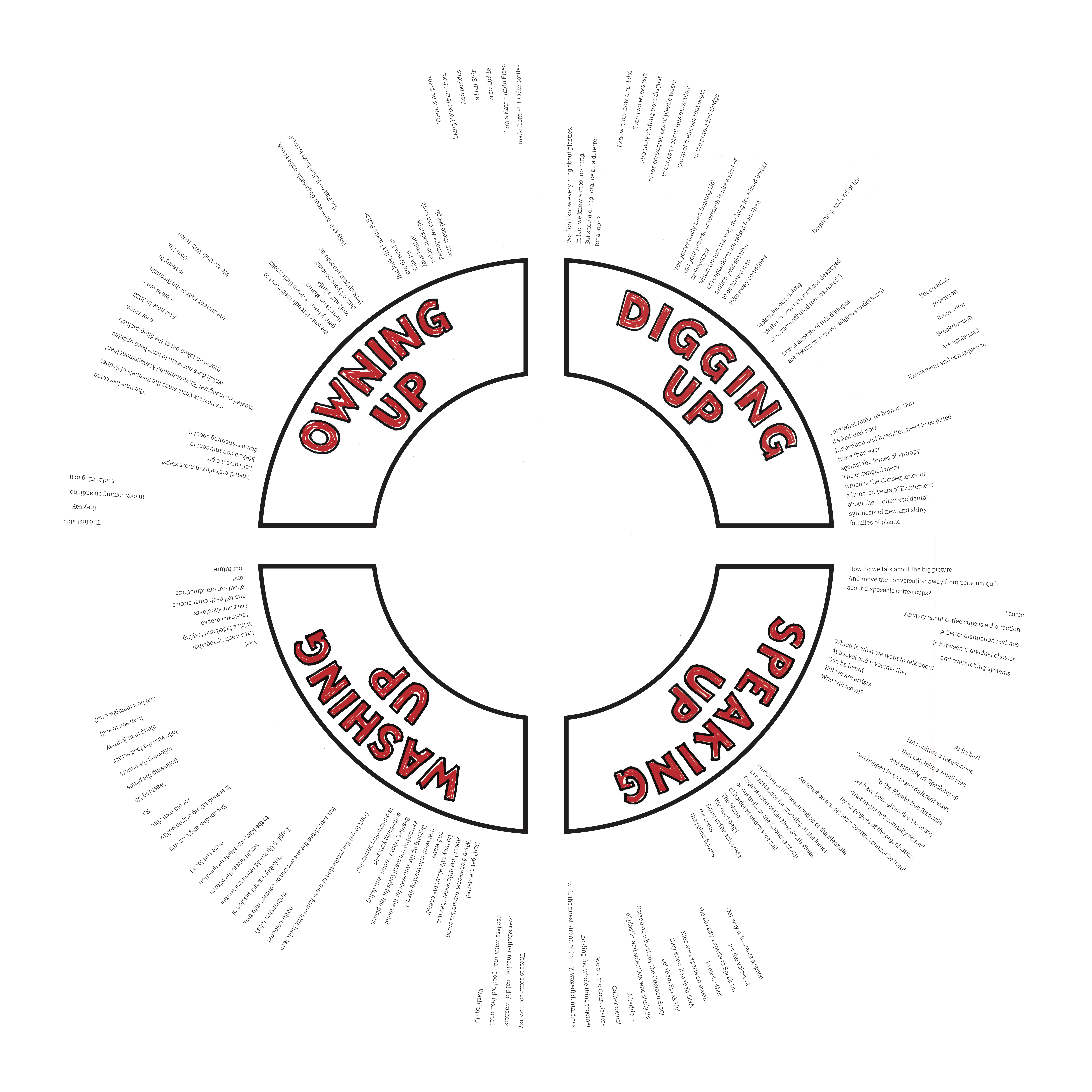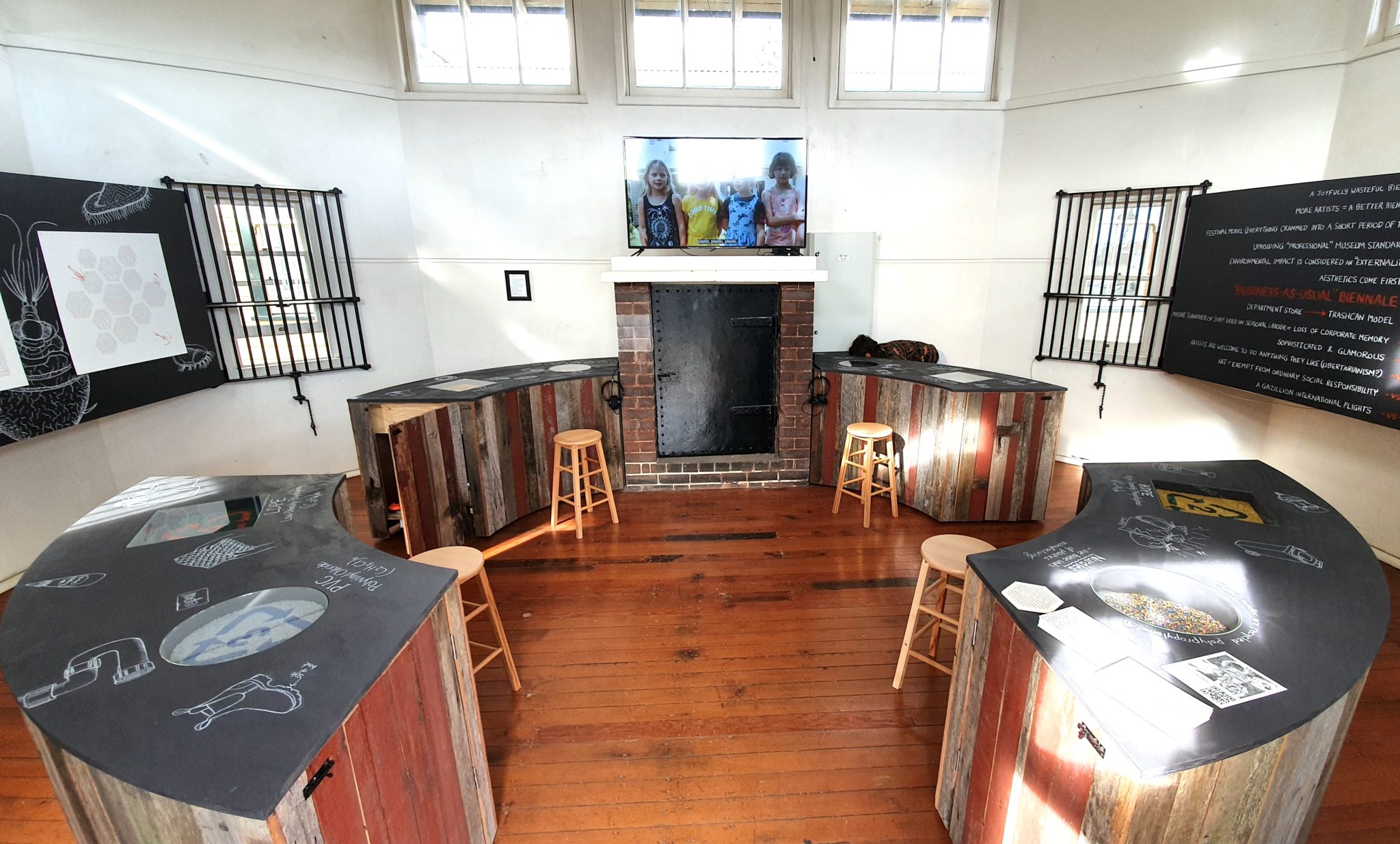What is the function of a manifesto? And how far can you stretch the definition before it becomes meaningless? And then, even if you fall short of making something properly-manifesto-like, could the failed attempt be useful in its own right? (And if so, useful for what?) It’s with these questions in mind that I continue my ruminations on the role of manifesti in the Plastic-free Biennale project.
As I discussed in an earlier blog post, our first attempts at creating a Plastic-free Manifesto resulted in three things:
- A what should we do? reflective dialogue, in which we nervously mapped out our relationship to the problem underpinning our project;
- A CAPITAL-LETTERS-WALL-OF-WORDS inventory of all the plastic crap in our houses (our so-called “concrete poem”);
- And a short punchy poem contributed by Wadi-Wadi elder Aunty Barbara Nicholson.
Perhaps Aunty Barb’s invective against the tut-tutting of a white do-gooder visiting a remote Aboriginal community comes closest to sounding like a real manifesto (Declarative! // For This! // Against That!). But Kim and I felt like we hadn’t yet scratched the manifesto itch – and our ongoing case of pruritus turned out to be generative.
Take, for instance, our next attempt – a circular text we called The Growing Up Hub. Its composition happened like this: we sat with our laptops on opposite sides of a large table, emailing each other fragments of text, chuckling and responding to each other’s fragments with further fragments, and so on, for a few hours, until it was done: an epistolary dialogue growing in real-time. Its themes were fourfold:
- DIGGING UP
(what do we know about plastics? what don’t we know? how can we find out?) - SPEAKING UP
(someone should say something! WE should say something!) - WASHING UP
(a metaphor: bloody hell, it’s time to take responsibility for these dirty dishes!) - OWNING UP
(how does an organisation take responsibility? with a new policy? is that it?)
The Growing Up Hub dialogue-manifesto is not exhaustively long, but at the same time, it never ends because we have laid out the text as a circle:

The broken-circle shape, I should add, was informed by the “hub benches” at the heart of our Biennale installation at Cockatoo Island. These four curved segments were designed to encourage dialogue amongst visitors. The circle with easily navigable openings… a metaphor for a particular kind of conversation, and an architectural embrace for our bodies at the same time.

For the “Growing Up Hub” dialogue we chose very consciously to be influenced by Helen Mayer Harrison and Newton Harrison. The Harrison’s conversations, which constitute a major part of their 1970s oeuvre, play back and forth (sometimes subtly, sometimes dramatically), weighing up how to tackle whatever curly social-ecological situation they’d gotten themselves into. Here’s a classic dialogue fragment clipped from the Harrisons’ epic Lagoon Cycle (1974-78):
I said
What would happen if I told you the story just as it occurredYou said
How could you
Every time we recreate the past it is differentI said
Then let us reinvent ourselvesYou said
We are always doing that anywayI said
Let’s do it publiclyYou said
From one point of view or another everything is visible and public
… and on and on… Amid the to-and-fro of the Lagoon Cycle, Helen and Newton meditate on a problem they’d been invited to investigate in Sri Lanka: the ecology of an estuary and the mystery of a crab species on the edge of population collapse. Taking on two personae with distinct voices – the Lagoon Maker and the Witness (which may or may not map neatly onto their own voices, we never find out for sure) – the Harrisons put forth propositions around the estuary/crab/human problem … only to dismantle those propositions … and make new ones … and so forth. Their dialogue-narrative is socratic and sometimes nigglesome (they were spouses after all), and it permits the texture of the problem-situation to emerge: multifarious, fragmentary, irresolvable, and puzzlingly enticing.
This kind of reflective dialogue is about as far from a recognisable manifesto as I can imagine. But, as Scottish artist and eco-arts champion Chris Fremantle has observed, perhaps that’s the point. The Harrisons’ conversations worry at a situation from so many different angles that any kind of simplistic manifesto becomes impossible. It’s not about knowing the right answers, Fremantle says, but “knowing the right questions to ask”. (An anti-manifesto, then?)
And so by the time we were ready to commit to our new Plastic-free Biennale dialogue-manifesto (January 2020), it was with the influence of the Harrisons consciously in mind. Our Manifesto for Growing Up begins like this:
We don’t know everything about plastics.
In fact we know almost nothing.
But should our ignorance be a deterrent
for action?I know more now than I did
Even two weeks ago
Strangely shifting from disgust
at the consequences of plastic waste
to curiosity about this miraculous
group of materials that begin
in the primordial sludgeYes, you’ve really been Digging Up!
And your process of research is like a kind of
archaeology
which mirrors the way the long-fossilised bodies
of zooplankton are raised from their
million year slumber
to be turned into
take away containers.
Like the Harrisons’ investigation of the lagoon ecosystem, our dialogue as it develops turns over the archaeology of plastic and its troublesome/utopian relationship with human ingenuity, without ever resolving itself. By the time we came to compose this text, we had obtained a strong sense of the difficulties facing the Biennale of Sydney: the tension between the organisation’s desire to transform its environmental footprint and the barriers standing in the way of success. Bits of this are woven into the text. The tone is something like this: We don’t presume to know the answers … but we’re pretty confident nobody else does either … so we feel confident to ask ignorant questions in front of the public.
The time has come
it’s now six years since the Biennale of Sydney
created its inaugural “Environmental Management Plan”
which does not seem to have been updated
(nor even taken out of the filing cabinet)
ever since.
And now, in 2020
— bless ’em —
the current staff of the Biennale
is ready to
Own Up.
We are their Witnesses.We walk through their doors to
gently breathe down their necks
there is no shame
well, just a little
Dust off your policies!
Perk up your procedures!Holy shit, hide your disposable coffee cups,
the Plastic Police have arrived!
Leave a comment